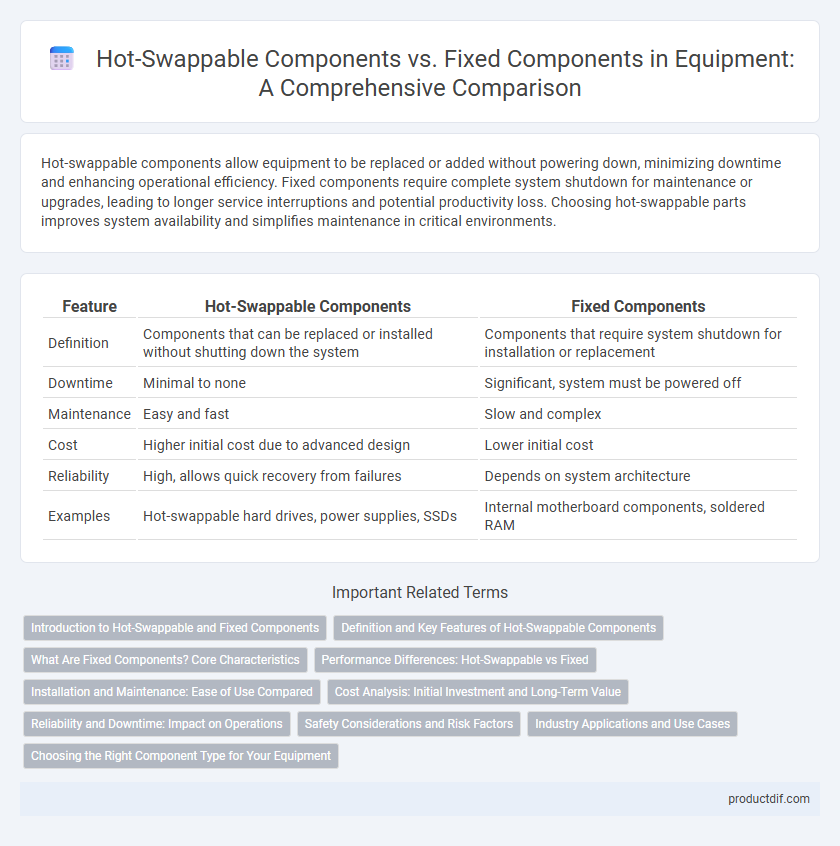Hot-swappable components allow equipment to be replaced or added without powering down, minimizing downtime and enhancing operational efficiency. Fixed components require complete system shutdown for maintenance or upgrades, leading to longer service interruptions and potential productivity loss. Choosing hot-swappable parts improves system availability and simplifies maintenance in critical environments.
Table of Comparison
| Feature | Hot-Swappable Components | Fixed Components |
|---|---|---|
| Definition | Components that can be replaced or installed without shutting down the system | Components that require system shutdown for installation or replacement |
| Downtime | Minimal to none | Significant, system must be powered off |
| Maintenance | Easy and fast | Slow and complex |
| Cost | Higher initial cost due to advanced design | Lower initial cost |
| Reliability | High, allows quick recovery from failures | Depends on system architecture |
| Examples | Hot-swappable hard drives, power supplies, SSDs | Internal motherboard components, soldered RAM |
Introduction to Hot-Swappable and Fixed Components
Hot-swappable components allow equipment to be replaced or added without shutting down the system, enhancing uptime and maintenance efficiency in critical environments like data centers and manufacturing plants. Fixed components require the system to be powered down for installation or replacement, which can result in operational downtime and increased maintenance complexity. Understanding the distinction between these component types is essential for designing reliable, scalable equipment systems that meet performance and serviceability requirements.
Definition and Key Features of Hot-Swappable Components
Hot-swappable components are hardware parts designed to be removed or replaced without shutting down the system, enabling continuous operation and minimizing downtime. Key features include live insertion and removal capabilities, compatibility with system buses like USB, SATA, or PCIe, and built-in safeguards to prevent data loss or hardware damage during swaps. These components enhance system flexibility, maintenance efficiency, and uptime in critical computing environments.
What Are Fixed Components? Core Characteristics
Fixed components refer to equipment parts that are permanently installed and cannot be removed or replaced without shutting down the system. Core characteristics include stability, durability, and a design that prioritizes secure, long-term integration within the device. These components often provide foundational functionality and contribute to the overall structural integrity of the equipment.
Performance Differences: Hot-Swappable vs Fixed
Hot-swappable components enhance system uptime by allowing replacement or upgrade without powering down, minimizing performance interruptions. Fixed components require system shutdown for maintenance, causing downtime and reduced operational efficiency. Performance optimization is more dynamic with hot-swappable technology, crucial for mission-critical equipment requiring continuous availability.
Installation and Maintenance: Ease of Use Compared
Hot-swappable components enable equipment installation and maintenance without powering down the system, significantly reducing downtime and operational disruptions. Fixed components require complete shutdowns for installation or repairs, leading to longer service intervals and increased risk of data loss or hardware damage. Enterprises benefit from hot-swappable designs through enhanced system availability and streamlined maintenance workflows.
Cost Analysis: Initial Investment and Long-Term Value
Hot-swappable components often demand a higher initial investment due to advanced design and additional safety mechanisms compared to fixed components. Over time, the ability to replace hot-swappable parts without system downtime translates into significant cost savings in maintenance and operational efficiency. Fixed components, while generally cheaper upfront, may incur higher long-term costs due to prolonged system outages and more complex repair processes.
Reliability and Downtime: Impact on Operations
Hot-swappable components significantly enhance equipment reliability by allowing replacement or maintenance without shutting down the system, minimizing operational downtime. Fixed components require complete system shutdown for repairs, increasing the risk of extended downtime and disrupting workflows. Prioritizing hot-swappable technology improves operational continuity and reduces maintenance-related delays in critical equipment.
Safety Considerations and Risk Factors
Hot-swappable components significantly reduce downtime and enhance safety by allowing maintenance without powering down equipment, minimizing electrical shock and thermal hazards. Fixed components, while potentially more stable structurally, pose higher risk during servicing due to necessary power interruptions and exposure to live circuits. Risk assessments prioritize hot-swappable designs in critical systems to prevent accidental injuries and equipment damage during operation.
Industry Applications and Use Cases
Hot-swappable components are critical in industries requiring continuous operation, such as data centers and manufacturing plants, allowing equipment to be replaced or upgraded without shutting down systems. Fixed components are commonly used in scenarios where reliability and structural integrity are prioritized over rapid maintenance, such as in heavy machinery and aerospace applications. The choice between hot-swappable and fixed components directly impacts operational uptime, maintenance costs, and system flexibility in various industrial environments.
Choosing the Right Component Type for Your Equipment
Selecting between hot-swappable components and fixed components depends on equipment uptime requirements and maintenance ease. Hot-swappable components enable quick replacement without shutting down the system, ideal for mission-critical environments needing minimal downtime. Fixed components often offer higher stability and lower cost but require system power down for servicing, suitable for less time-sensitive applications.
Hot-swappable components vs fixed components Infographic

 productdif.com
productdif.com